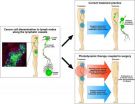(Press-News.org) Millbrook, NY— If society wants to address big picture environmental problems, like global climate change, acid rain, and coastal dead zones, we need to pay closer attention to the Earth's coupled biogeochemical cycles. So reports a special issue of Frontiers in Ecology and the Environment, published this month by the Ecological Society of America.
"There are nearly seven billion people on the planet. And our activities are throwing the Earth's biogeochemical cycles out of sync, to the detriment of air and water resources, climate stability, and human health," comments Dr. Jonathan J. Cole, a limnologist at the Cary Institute of Ecosystem Studies and co-editor of the special issue.
A biogeochemical cycle is a pathway by which a chemical element, such as carbon, moves through Earth's biosphere, atmosphere, hydrosphere, and lithosphere. Some thirty cycles govern the composition of our environment, among them carbon, nitrogen, oxygen, and phosphorus.
Historically, biogeochemical cycles have been studied individually. But in the natural world, element cycles are intimately tied to one another, and seemingly small perturbations can have large impacts across cycles.
The Frontiers issue puts forth a new framework for understanding the biological, geological, and chemical processes that shape element cycles, and the ways in which they are coupled to one another.
It represents one of the first efforts to convene atmospheric scientists and ecologists on the topic. In addition to Cole, it was edited by Drs. Adrien C. Finzi of Boston University and Elisabeth A. Holland of the National Center for Atmospheric Research.
Dr. William H. Schlesinger, president of the Cary Institute and a contributor, notes, "The coupled biogeochemical cycle framework not only explains the causes of many of today's leading environmental problems, it provides a road map for finding solutions at the global scale."
Consider the connection between farms and fish. In the U.S., two-thirds of our estuaries are degraded by nitrogen and phosphorus pollution, which is often a by-product of agriculture. Livestock waste and crop fertilizer make their way into coastal waterways, where they stimulate algal blooms that strip oxygen from deep waters, degrade sensitive habitat, and ultimately kill fish.
A better understanding of how nitrogen, phosphorus, and oxygen cycles interact could help balance agricultural needs with the health and productivity of estuaries.
Coupled-cycles can also strengthen our ability to predict and manage climate change. Forests play a role in removing carbon dioxide from the atmosphere. A forest's ability to sequester atmospheric carbon—an attribute that helps minimize climate change—is tied to nitrogen, phosphorus, and water availability. Yet current global climate models don't incorporate these couplings in realistic ways.
An integrated view could provide a more accurate view of forest carbon sequestration limits, while helping to guide sustainable forestry practices.
Dr. Finzi concludes, "We are at a turning point. From satellite imagery to real-time environmental monitoring, we have the technology needed to reveal how coupled biogeochemical cycles shape the world and how our actions disrupt them. Now we need to focus on integrating data across observational and experimental networks and applying insights to management decisions."
INFORMATION:
The Frontiers issue was supported by the National Science Foundation, and is available online at http://www.esajournals.org/toc/fron/9/1
The Cary Institute of Ecosystem Studies is a private, not-for-profit environmental research and education organization in Millbrook, N.Y. For more than twenty-five years, Cary Institute scientists have been investigating the complex interactions that govern the natural world. Their objective findings lead to more effective policy decisions and increased environmental literacy. Focal areas include air and water pollution, climate change, invasive species, and the ecological dimensions of infectious disease. Learn more at www.caryinstitute.org
Biogeochemistry at the core of global environmental solutions
A coupled-cycles framework is essential to balancing human needs with the health of the planet
2011-02-10
ELSE PRESS RELEASES FROM THIS DATE:
1 factor can make mortgage modifications up to one-third more likely, study finds
2011-02-10
COLUMBUS, Ohio – One factor, little-known by borrowers, can play a large role in whether banks are willing to renegotiate mortgages with homeowners who are struggling to meet payments.
Unfortunately, it is a factor that homeowners have no control over.
Researchers found that mortgages owned by lenders were 26 to 36 percent more likely to be renegotiated than very similar mortgages that the original lenders sold to other companies, which turned them into securities.
"Homeowners don't have a say in whether their bank sells their mortgage or not, but that can have a ...
Behavioral problems linked to cortisol levels
2011-02-10
Montreal, February 9, 2011 – Cortisol, the so-called stress hormone, seems to behave in contradictory ways in children. Some youngsters with behavioral problems have abnormally high levels of cortisol, while others with identical problems have abnormally low levels. What's going on?
Researchers at Concordia University and the Centre for Research in Human Development may have resolved the cortisol paradox. In a groundbreaking study published in the journal Hormones and Behavior, they link cortisol levels not simply to behavior problems, but to the length of time individuals ...
Beyond Alzheimer's: Research explores hippocampal sclerosis
2011-02-10
LEXINGTON, Ky. (Feb. 9, 2011) - The population of aged persons worldwide is expanding rapidly, and it is becoming increasingly clear that there are many different diseases that affect the minds of these individuals. Researchers at the University of Kentucky are breaking new ground in the ongoing project of identifying and defining those diseases most likely to affect an aged population. Dr. Peter Nelson of the University of Kentucky Sanders-Brown Center on Aging is the lead author on a paper soon to be published in the journal BRAIN; the paper deals with the little-understood ...
Crocodile tears don't fool us all
2011-02-10
How easy is it to fake remorse? Not so easy if your audience knows what to look for. In the first investigation of the nature of true and false remorse, Leanne ten Brinke and colleagues, from the Centre for the Advancement of Psychology and Law (CAPSL), University of British Columbia and Memorial University of Newfoundland in Canada, show that those who fake remorse show a greater range of emotional expressions and swing from one emotion to another very quickly - a phenomenon referred to as emotional turbulence - as well as speak with more hesitation. These findings have ...
Personal well-being is linked to national satisfaction, especially when times are tough
2011-02-10
The country where you live can have a big impact on your life. A new study of people from 128 countries finds that the more satisfied people are with their country, the better they feel about their lives—especially people who have low incomes or live in relatively poor countries.
The study, published in the latest issue of Psychological Science, a journal of the Association for Psychological Science, is based on a Gallup World Poll that reached about 1,000 people in each of 128 countries, obtaining a total of more than 130,000 responses. People were asked a series of ...
Cocaine production increases destruction of Colombia's rainforests
2011-02-10
Cultivating coca bushes, the source of cocaine, is speeding up destruction of rainforests in Colombia and threatening the region's "hotspots" of plant and animal diversity, scientists are reporting in a new study. The findings, which they say underscore the need for establishing larger protected areas to help preserve biodiversity, appear in ACS' journal Environmental Science & Technology.
Liliana M. Dávalos and colleagues note that the pace of deforestation in Colombia has accelerated over the past 20 years, even as population growth has slowed and the economy has shifted ...
Greener process for key ingredient for everything from paint to diapers
2011-02-10
Scientists are reporting discovery of an environmentally friendly way to make a key industrial material — used in products ranging from paints to diapers — from a renewable raw material without touching the traditional pricey and increasingly scarce petroleum-based starting material. Their report on a new catalyst for making acrylic acid appears in ACS Catalysis, the newest in the American Chemical Society's suite of 39 peer-reviewed scientific journals.
Weijie Ji, Chak-Tong Au, and colleagues note that acrylic acid is essential for making paints, adhesives, textiles, ...
Toward a fast, simple test for detecting cholera rampaging in 40 countries
2011-02-10
With cholera on the rampage in Haiti and almost 40 other countries, scientists are reporting the development of a key advance that could provide a fast, simple test to detect the toxin that causes the disease. The report appears in ACS' journal Bioconjugate Chemistry. Cholera affects more than 200,000 people annually, mainly in developing countries, and causes about 5,000 deaths. Many involve infants, children, and the elderly.
J. Manuel Perez and colleagues note that cholera is an intestinal infection from food or water contaminated with the bacterium Vibrio cholerae. ...
A green way to cap an old landfill
2011-02-10
This release is available in Spanish.
U.S. Department of Agriculture (USDA) scientist Pat Millner and safety manager David Prevar have worked with the U.S. Environmental Protection Agency (EPA) and private consultants to design and conduct a pilot study for an alternative way to cap landfills.
Millner is a microbiologist at the 6,615-acre Henry A. Wallace Beltsville Agricultural Research Center (BARC) operated in Beltsville, Md., by the Agricultural Research Service (ARS), the chief intramural scientific research agency of USDA.
Prevar oversees safety and health issues ...
Photodynamic therapy against cancer
2011-02-10
Tumor cells have several routes that enable them to move from the primary tumor to distant tissues, a process called metastasis. It is metastasis of the primary tumor that kills most cancer patients. One of the least studied routes of metastasis is the lymphatic system. Many tumors produce factors that promote the formation of new lymphatic vessels (lymphangiogenesis). The newly formed lymphatic vessels enable tumor cells to travel from the primary tumor to the regional lymph nodes from whence they can spread throughout the body.
Current treatment practice is to surgically ...
LAST 30 PRESS RELEASES:
Injectable breast ‘implant’ offers alternative to traditional surgeries
Neuroscientists devise formulas to measure multilingualism
New prostate cancer trial seeks to reduce toxicity without sacrificing efficacy
Geometry shapes life
A CRISPR screen reveals many previously unrecognized genes required for brain development and a new neurodevelopmental disorder
Hot flush treatment has anti-breast cancer activity, study finds
Securing AI systems against growing cybersecurity threats
Longest observation of an active solar region
Why nail-biting, procrastination and other self-sabotaging behaviors are rooted in survival instincts
Regional variations in mechanical properties of porcine leptomeninges
Artificial empathy in therapy and healthcare: advancements in interpersonal interaction technologies
Why some brains switch gears more efficiently than others
UVA’s Jundong Li wins ICDM’S 2025 Tao Li Award for data mining, machine learning
UVA’s low-power, high-performance computer power player Mircea Stan earns National Academy of Inventors fellowship
Not playing by the rules: USU researcher explores filamentous algae dynamics in rivers
Do our body clocks influence our risk of dementia?
Anthropologists offer new evidence of bipedalism in long-debated fossil discovery
Safer receipt paper from wood
Dosage-sensitive genes suggest no whole-genome duplications in ancestral angiosperm
First ancient human herpesvirus genomes document their deep history with humans
Why Some Bacteria Survive Antibiotics and How to Stop Them - New study reveals that bacteria can survive antibiotic treatment through two fundamentally different “shutdown modes”
UCLA study links scar healing to dangerous placenta condition
CHANGE-seq-BE finds off-target changes in the genome from base editors
The Journal of Nuclear Medicine Ahead-of-Print Tip Sheet: January 2, 2026
Delayed or absent first dose of measles, mumps, and rubella vaccination
Trends in US preterm birth rates by household income and race and ethnicity
Study identifies potential biomarker linked to progression and brain inflammation in multiple sclerosis
Many mothers in Norway do not show up for postnatal check-ups
Researchers want to find out why quick clay is so unstable
Superradiant spins show teamwork at the quantum scale
[Press-News.org] Biogeochemistry at the core of global environmental solutionsA coupled-cycles framework is essential to balancing human needs with the health of the planet


